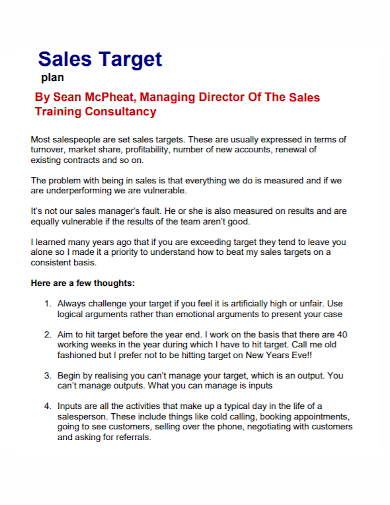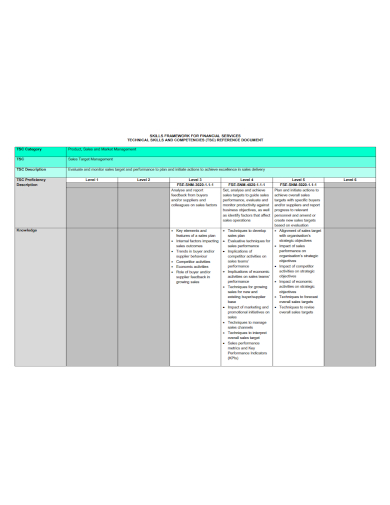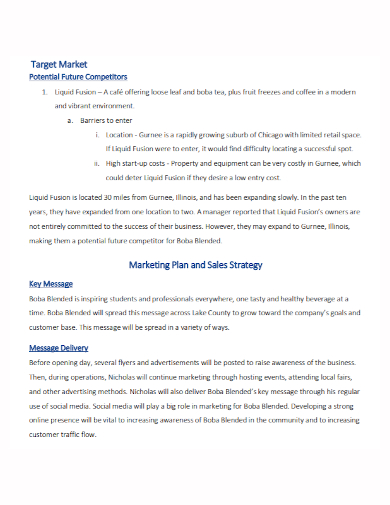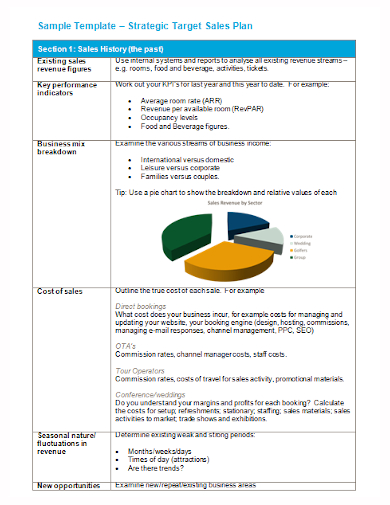The best-laid sales plans in your head pale in comparison to a well-crafted yearly sales target plan. Your annual plan’s thought process aids in determining how your company will achieve its sales objectives while also providing a road map for getting there. The strategy also aids your team in grasping the big picture as well as all of the details necessary to find prospects and convert them into paying customers. It’s a great time to regroup, recalibrate, and prepare our sales teams to hit the year-end sales action revenue goals we’ve set for them as we near the end of the first half of the year. Perhaps your team has gotten a little off track since the goal was set? Your team will have a roadmap to follow and renewed motivation for how to achieve your sales target if you assess your current situation and create an updated action plan.
5+ Sales Target Plan Samples
A sales target is the number of products that must be sold in order to make a profit. Sales teams thrive when they have clear sales goals. Reliable sales targets also enable you to track your sales progress over time and adjust your sales goals to meet your market and business requirements. You can set goals for each member of your sales team, as well as by market segment and region.
1. Sales Target Plan Template

2. Sales Target Training Plan
3. Sales Target Management Plan
4. Sales Target Compensation Plan
5. Sales Target Strategy Plan
6. Sample Sales Target Plan
How to Make Sales Target Plan
- Set the objectives – Setting objectives for your annual sales target plan necessitates reviewing your current sales figures as well as reviewing how things have progressed over the previous year. Examine the number of new customers who purchased your product or service in the previous year and calculate the average revenue per customer. Then, set a sales goal for the next 12 months, describing where you want sales to be. Divide your goals into monthly or quarterly targets.
- Review target market – Describe your target market so that your sales team knows what to look for when looking for new clients. Explain common characteristics of residential homeowners, such as income level, where they live, familial status, and the mediums they use to learn about products or services if you’re selling to them. Break down your target market into industries and specific companies you want to approach if you’re selling to businesses.
- Determine sales strategies – Outline the sales strategies you’ll need to achieve your goals. Include tactics like calling current customers to persuade them to purchase more and cold-calling to generate new business. Describe how you intend to generate leads and convert prospects into customers using traditional and digital marketing strategies. Give an estimate of how many leads you want to collect if you plan to attend a trade show or rent a booth at one.
- List the needed resources – Examine your company’s marketing strategy to see what resources you or your sales team can use to help them meet their sales targets. Use both digital and traditional marketing tools to find and persuade people to buy, such as brochures, sales fliers, a website, and social media networking. Describe any internal promotions your company plans to offer, such as sales contests, to get your sales staff on board with your plan.
- Set tracking schedule – Don’t wait until the end of the year to figure out how much money you’ve made. Instead, create a tracking schedule to check in on your goals and progress every month or quarter, depending on the goals you’ve set. In addition, at your weekly sales staff meeting, review your sales target plan to assess your progress, celebrate any milestones your team achieves, and keep everyone focused on the overall goal.
FAQs
What are the types of sales targets?
- Sales targets by product – Setting specific goals for each product is a quick and easy way to stay on track with your monthly sales budget. To achieve a budgeted profit, product sales targets usually include the number of products you need to sell as well as the targeted average sale price.
- Sales targets by market segment – When it comes to setting effective sales targets, market segmentation — or segmenting your market — is a good place to start. Setting sales targets by market segment, on the other hand, can be difficult. Segmenting your market entails grouping customers with similar needs and characteristics, as well as customers who respond to your products or services in similar ways.
- Sales targets by region – Businesses with area or traveling sales representatives frequently set sales targets by region, which eliminates the difficulty and frustration of setting and monitoring individual targets for a large number of products. These companies find it easier to set a dollar target per region, which covers the entire product range as well as all of the customers in that area.
How do you set sales targets?
– Think about the profit margins that each of your sales will achieve (there’s no point in meeting your sales target if you have to reduce your margin to do so).
– Be realistic — your goals must be backed up by data from your marketing plan.
– Consider all of your company’s expenses and make expansion plans.
Creating a sales action plan should be your top priority when it comes to increasing sales and meeting your company’s performance goals. Check out some of the sales target plan samples and templates provided in the article for your reference if you want to see more samples and formats.
Related Posts
FREE 7+ Fashion Business Plan Samples in PDF
FREE 10+ Sprint Planning Samples In MS Word | Google Docs | PDF
FREE 10+ Wedding Planning Samples in MS Word | Apple Pages | Powerpoint | PDF
FREE 9+ Monthly Study Planner Samples in PSD | Illustrator | InDesign | PDF
FREE 9+ Sample Curriculum Planning Templates in PDF | MS Word
FREE 10+ Teacher Development Plan Samples in MS Word | Google Docs | Apple Pages | PDF
FREE 10+ Basketball Practice Plan Samples in PDF
FREE 12+ School Business Plan Samples in PDF | MS Word | Apple Pages | Google Docs
FREE 7+ Client Strategic Plan Samples in PDF | MS Word
FREE 11+ Trucking Business Plan Templates in PDF | MS Word | Google Docs | Pages
FREE 7+ Small Hotel Business Plan Samples PDF | MS Word | Apple Pages | Google Docs
FREE 14+ Bakery Business Plans in MS Word | PDF | Google Docs | Pages
FREE 4+ Yearly Lesson Plan Samples in PDF
FREE 50+ Strategic Planning Samples in Google Docs | Pages | PDF | MS Word
FREE 10+ Construction Project Plan Samples in MS Word | Google Docs | Apple Pages | PDF





